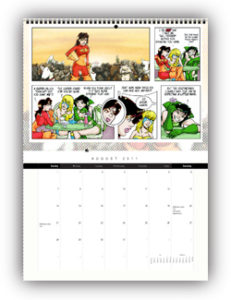Best of Webcomics.com — July 2017
July was an excellent example of the tremendous value offered by a subscription to Webcomics.com. My readers got early alerts on issues that would impact their businesses, helpful tutorials, insightful analysis, and meaningful feedback on their work. Here are some samples of what you may have missed…
 Updated Patreon header template
Updated Patreon header template
Patreon’s header image gets sliced and diced more than Wolverine’s keyboard. It gets re-sized depending on the monitor-resolution of the person visiting your Patreon page, and it gets cropped ruthlessly when you post a link to your page from Facebook or Twitter.
When Patreon updated its site layout, it introduced some dead zones into the header. And, to be honest, Twitter has been showing the header preview more similar to Facebook’s presentation. So, an update has been long overdue.
So here’s an updated Photoshop template to help you make the most of your header. [Subscribers can read the entire post]
When is a complaint actually a compliment?
It sounds like a weird webcomics riddle, doesn’t it? “When is a complaint actually a compliment?” After all, as webcartoonists, we’ve always prided ourselves one the granular level of interaction that we maintain with our readers. Both the original “How To Make Webcomics” book and the updated version, “The Webcomics Handbook” devoted an entire chapter to it. One could argue that it’s a definitive feature of webcomics.
So, it stands to reason that when readers complain, we webcartoonists become very concerned.
And we do — we should.
Except when we shouldn’t.
Here’s what you need to understand…
 Facebook — To Link or Not to Link
Facebook — To Link or Not to Link
I see this advice getting passed around on Facebook quite frequently: “If you include a link to your website, the Facebook algorithm will kill your post.” Let’s talk about how accurate this advice is — and some Best Practices for promoting on Facebook.
First of all, let’s try to understand the issue a little more clearly.
[Subscribers can read the entire post]
How to do a reader survey
Reader surveys are an excellent way to get a better feel for your audience. Does your comic skew towards female reader? Do they tend to be younger or older? What are their other interests? would they support a Kickstarter for a new book? What rewards would make them Patreon backers?
In fact, we’ve posted a helpful DIY tutorial so you can ask all of the questions you need to ask — without paying for a potentially-expensive service like SurveyMonkey.
But what if you’re not getting a very healthy response from your readers? Should you seek out additional respondents? Advertise for more input? Solicit other cartoonists?
Be very careful, your quest for more information could result in your getting very, very bad information. And that’s downright dangerous. Here’s why…
[Free Friday — You can read this entire piece without a subscription.]
Patreon Hot Seat — Call for participants
We launched another critique series that focuses on Patreon campaigns. It’s becoming more and more important to get this right.
Facebook announces subscription-only news
Facebook is announcing a new initiative — The Street — which will offer news on a subscription-only basis. Via Reuters:
(Reuters) – Facebook Inc plans to launch a subscription-based news product, and will begin initial tests in October, TheStreet reported on Tuesday, citing the social media company’s news partnerships head Campbell Brown at a conference.
The feature is likely to allow publishers to create a paywall on Facebook’s Instant Articles and guide readers to a publisher’s home page to opt for a digital subscription, according to TheStreet report.
This follows a trend that I’ve been talking about here on Webcomics.com for years. As ad-blockers continue to constrict passive revenue, Web publishers will have to turn to more active-revenue means. That means more subscriptions and more crowdfunding.
So, the question is… have you prepared for this — and if not, what do you need to do to be prepared?
I have some thoughts.
 Start planning holiday merchandise now!
Start planning holiday merchandise now!
Merry Christmas — and Happy New Year!
Set down the sunblock, and step away from the pool. It’s time to start planning for December and January.
I know it’s hard to get into the spirit, but this is the time to start working on merchandise for the holiday shopping season. In recent years, webcartoonists have offered an increasing compliment of holiday goodies that have ranged from specialty T-shirts and mugs to holiday-themed greeting cards. And let’s not forget to add calendars to that list. Those will start appearing in stores by November — at the latest!
So, let’s take a closer look at some of those specialty products, and how we can start working now to be ready to compete when the snow falls.
[Subscribers can read the entire post]
Anatomy of a convention banner stand
Recently, I saw a webcartoonist asking for advice on convention banners. It’s a deceptively tricky topic — and it’s something I see done poorly at con after con.
Before you shell out your hard-earned dough on another convention banner that doesn’t work, take a little friendly advice:
 The primary purpose of a convention banner is to attract attention to your table. Therefore, you need to get everything as high as possible. Putting important information at the bottom of your banner is a mistake — especially if the banner is going to be placed on the floor behind your table. Think about it. No one sees anything below the middle of a vertical banner from the aisle.
The primary purpose of a convention banner is to attract attention to your table. Therefore, you need to get everything as high as possible. Putting important information at the bottom of your banner is a mistake — especially if the banner is going to be placed on the floor behind your table. Think about it. No one sees anything below the middle of a vertical banner from the aisle.
For the same reason, any type that’s not readable from about 20 ft away is too small. Make that type big!
And here’s one that has become even more important as webcomics have grown — do you promote the comic or promote the creator? There are pros and cons either way. But make your choice consistent. If the banner promotes the creator at the very top, be sure that the listing in the program matches. After 16 years of conventions, I can’t tell you how many problems I’ve caused for myself by bringing my “Evil Inc” banner to a con that I’m listed in the program as “Brad Guigar.”
You’d think I’d learn…
[Free Friday — You can read this entire piece without a subscription.]
Mailbag: How long should it take me to do a comic?
Q.: The time it takes me to draw, ink, and color a single comic is usually between 3-6 hours, am I going too slow? I’d like to be able to do more comics per week, but I work full time and I want my comics to stand out from the stick figure, copy and paste comics I come across.
A. You’re asking the wrong question.
[Subscribers can read the entire post]
Book plates
Offering an original illustration inside a book — as part of an Artist Edition — is a tremendous way to drive sales and/or Kickstarter pledges.
But… have you ever tried to do a decent drawing on the inside cover (or an inside page) of a book? It’s not easy. And — depending on the coating you used on your cover/pages — the ink doesn’t always take to the surface very well.
There’s got to be a better way…
[Subscribers can read the entire post]
Five Changes You Should Make Now
I’ve been saying it for the better part of the year — if you’re still doing things the way you did three years ago, you’re making a big mistake. Here are five “traditional” approaches to webcomics that you need to re-think… today.
[Free Friday — You can read this entire piece without a subscription.]
NCS announces “Young Professionals Program”
The National Cartoonist Society has made it easier for young people to join their organization. The Young Professional Program — nicknamed “The 27 Club” offers full membership for $27 to anyone under 27 years old.
Here’s what you need to know…
Using ID tags as part of your social-media and SEO strategy
Lately, I’ve been re-doubling my efforts towards blogging. There are two reasons. First, with two updates a week, it’s not only more important to take that opportunity to try to get my messages across, but it’s much easier than when I was doing a daily strip. Secondly, now that my business has shifted from a ad-supported to a subscriber-supported model, it’s crucial that I try to make that blog a bigger part of my outreach.
What I have found is that I have been able to use my beefed-up blog as part of a greater social-media strategy as well. And it’s all thanks to a very simple HTML tag.
[Free Friday — You can read this entire piece without a subscription.]




Recent comments